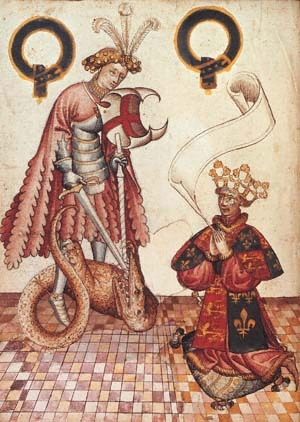Arms
 |
|
John Mynne was an English officer of arms. He was the son of Henry Mynne of Gloucestershire, and son-in-law [1] of John Writhe, the Garter King of Arms from 1478 to 1504.
It has been claimed that Mynne was York Herald under Henry VII, but this is disputed. Noble [2] lists him as York Herald, on the authority of Thomas Wriothesley's pedigrees, but neither Anstis nor the Herald's visitation of Gloucestershire lists him as York Herald.
Mynne's coat of arms was "Gules, on a chevron engrailed Or between three fleurs de lis Argent, three chessrooks Sable". [3]
Mynne was originally from Windrush in Gloucestershire, the son of Henry Mynne. [4] [5] He married Catherine, a daughter of John Writhe, and is mentioned in Writhe's will. [6] It is probable that John Mynne was also related to Anne Mynne, the third wife of John Writhe. Mynne had two daughters: Eleanor, who married Nicholas Cutler of Eye, MP, [7] and was the mother of Frances Cutler who married William Honnyng; [8] and Catherine, who married - Calthrope. [4]
 |
|

The College of Arms, or Heralds' College, is a royal corporation consisting of professional officers of arms, with jurisdiction over England, Wales, Northern Ireland and some Commonwealth realms. The heralds are appointed by the British Sovereign and are delegated authority to act on behalf of the Crown in all matters of heraldry, the granting of new coats of arms, genealogical research and the recording of pedigrees. The College is also the official body responsible for matters relating to the flying of flags on land, and it maintains the official registers of flags and other national symbols. Though a part of the Royal Household of the United Kingdom, the College is self-financed, unsupported by any public funds.

Garter Principal King of Arms is the senior king of arms and officer of arms of the College of Arms, the heraldic authority with jurisdiction over England, Wales and Northern Ireland. The position has existed since 1415.

Heraldic visitations were tours of inspection undertaken by Kings of Arms throughout England, Wales and Ireland. Their purpose was to register and regulate the coats of arms of nobility, gentry and boroughs, and to record pedigrees. They took place from 1530 to 1688, and their records provide important source material for historians and genealogists.
Sir Richard St George was a long-serving officer of arms at the College of Arms in London during the seventeenth century.

William Bruges was an English officer of arms. He is best remembered as the first person appointed to the post of Garter King of Arms, which is currently the highest heraldic office in England.
John Writhe was a long-serving English officer of arms. He was probably the son of William Writhe, who represented the borough of Cricklade in the Parliament of 1450–51, and is most remembered for being the first Garter King of Arms to preside over the College of Arms. Writhe is also notable for the contention that it was he who developed the system of heraldic cadency employed by English officers of arms to the present day.

Sir Thomas Wriothesley was a long serving officer of arms at the College of Arms in London. He was the son of Garter King of Arms, John Writhe, and he succeeded his father in this office.
Charles Wriothesley was a long-serving officer of arms at the College of Arms in London. He was the last member of a dynasty of heralds that started with his grandfather—Garter Principal King of Arms John Writhe.

John Anstis was an English officer of arms, antiquarian and politician who sat in the House of Commons between 1702 and 1722. He rose to the highest heraldic office in England and became Garter King of Arms in 1718 after years of political manoeuvring.

John Anstis was an officer of arms at the College of Arms in London.
Sir Christopher Barker was an officer of arms at the College of Arms in the City of London who rose to the highest position of Garter Principal King of Arms.

Ralph Bigland was an English officer of arms, antiquarian and cheesemaker. He was born at Stepney, Middlesex, and was the only son of Richard Bigland and his wife, Mary. His father was a native of Westmorland, descended from the Bigland family of Biglands. He should not be confused with his nephew Sir Ralph Bigland.
Henry Chitting was a long-serving officer of arms at the College of Arms in London.

Stephen Martin Leake was a numismatist and long-serving officer of arms at the College of Arms in London.
William Wriothesley or Wrythe was an officer of arms at the College of Arms in London. He was the second son of Garter King of Arms, John Writhe; the younger brother of Thomas Wriothesley; and the father of Thomas Wriothesley, 1st Earl of Southampton.
Nicholas Charles or Carles was an English officer of arms, who served as Lancaster Herald from 1609 to 1613. He made a copy of an early and rare 13th-century roll of arms, the original of which is now lost, known after him as "Charles's Roll".
Sir William Knyvett was an English knight in the late Middle Ages. He was the son of John Knyvett and Alice Lynne, the grandson of Sir John Knyvett, and assumed the titles of Sheriff of Norfolk & Suffolk, Burgess of Melcombe, Bletchingley, & Grantham, Constable of Rising Castle.
Sir Henry St George, the younger, was an English officer of arms. He was a younger son of the herald Henry St George (1581–1644).
Sir Henry St George (1581–1644) was an English Officer of arms. He was the third son of the herald Sir Richard St George and his wife Elizabeth St John.
Jane Dee (1555–1604/5) was an English gentlewoman and lady-in-waiting, whose married life is documented in the journals of her husband, the philosopher, occultist, and mathematician John Dee.